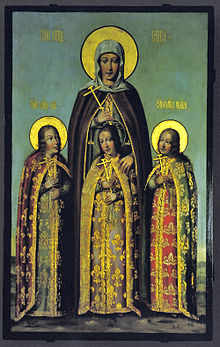Karp Zolotaryov
| Karp Zolotaryov | |
|---|---|

Holy martyrs Faith, Hope and Charity and their mother Sophia. Novodevichy Convent, 1685
|
|
| Born | Russia |
| Known for | Icons, carved iconostasis, interior design |
Karp Ivanovich Zolotaryov (Russian: Карп Иванович Золотарёв, fl. last quarter of the 17th century) was a Muscovite painter, interior designer and wood carver, employed by Posolsky prikaz and the Kremlin Armoury. Zolotaryov was the author of iconostasis of the Transfiguration church in Novodevichy Convent and the Church of the Intercession at Fili and the icons of Donskoy Monastery. Surviving paintings by Zolotaryov, created in the period directly preceding the reforms of Peter I, form a bridge between traditional Orthodox icon painting and the modern realistic painting introduced in Russia in the 18th century.
The identity of Karp Zolotaryov was discovered in archives by Ivan Snegiryov and first published in print in 1857. For the next hundred years Zolotaryov was known only through archival evidence: historians knew the sites where he worked and the themes of his icons but could not positively attribute the unsigned icons to the artist. In 1955 Elena Ovchinnikova was the first to attribute an apparently unsigned icon of the Fili church to Zolotaryov. In 1960s this was confirmed by a newly found autograph of Zolotaryov on the iconostasis of the Fili church; more autographs were discovered during restoration of its icons in 1973.
The year of birth and family origins of Zolotaryov are unknown. Official records declared him "a natural born and eternal slave" (Russian: прирождённый и вечный холоп) of the Tsar. In 1667–1672 Zolotaryov was an apprentice to Bogdan Saltanov, an Armenian-born lead painter of the Kremlin Armoury. By 1680 Zolotaryov, still employed by the Armoury, trained his own class of at least five identified apprentices. His 15-year tenure at the Armoury was dedicated primarily to the interiors of the Kremlin and country residences of the Romanovs. Work assignments included designing and carving furniture, painting palace frescoes and church art, realistic parsuna portraits and even a handmade calendar of the celestial movement (1679) for teaching Peter I who was then seven years old. All this artwork was eventually lost with the exception of two carved khorugv stakes.
...
Wikipedia
